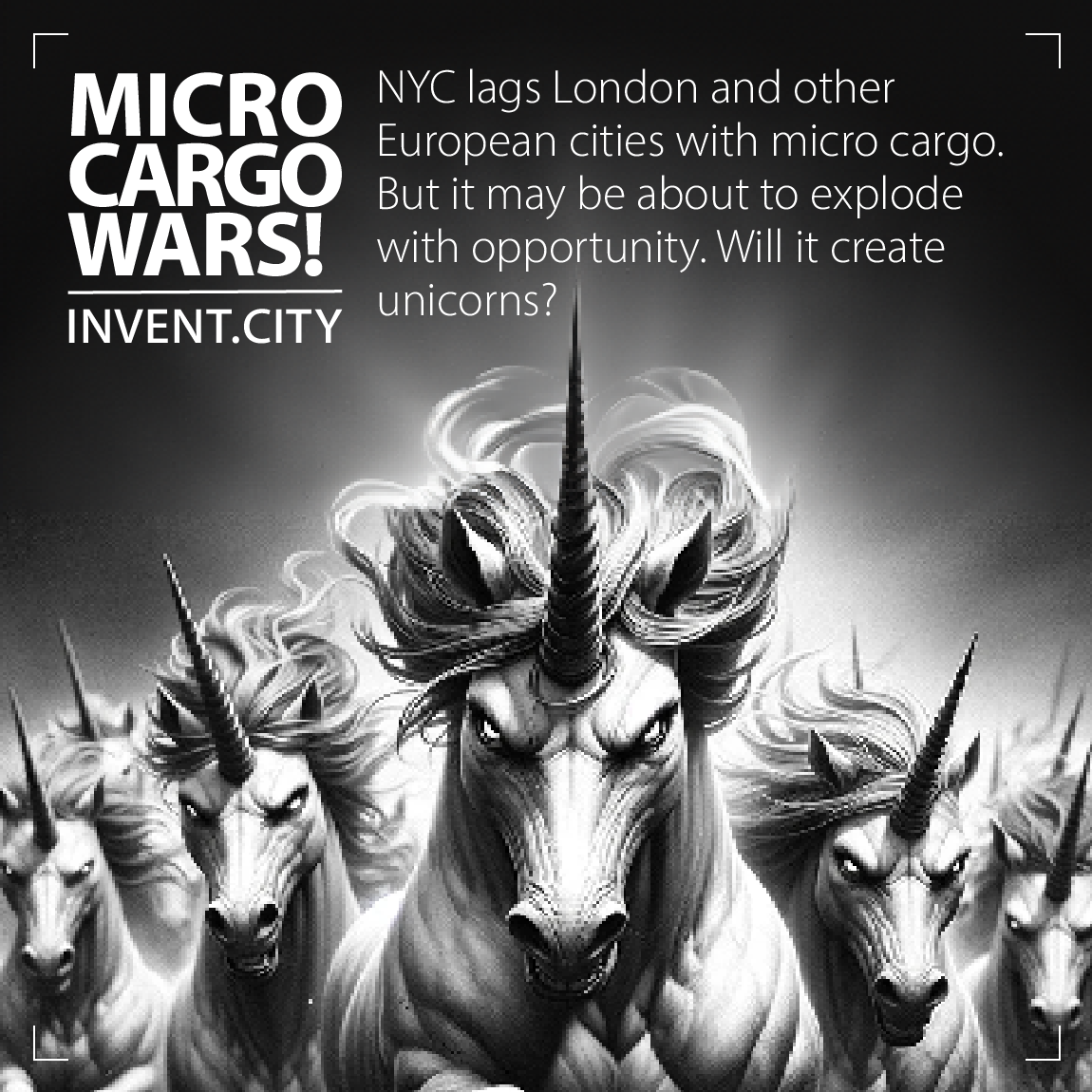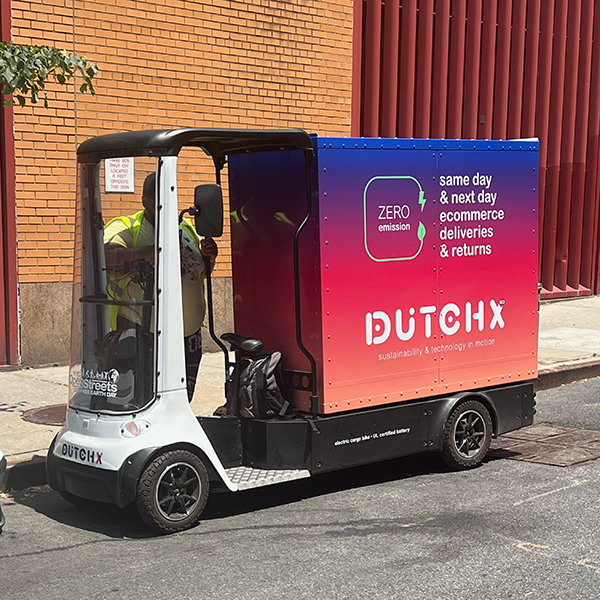
The purpose of this roundtable series is to tap the expertise of the private sector to develop a framework to deploy micro-cargo as part of a network of Urban Hubs in the Financial District (FiDi). Visit the Urban Hub page.


The purpose of this roundtable series is to tap the expertise of the private sector to develop a framework to deploy micro-cargo as part of a network of Urban Hubs in the Financial District (FiDi). Visit the Urban Hub page.

This last roundtable in the series focuses on creating an action plan for expanding micro cargo use over trucks. Special guests include Stephanie La Raja, former head of marketing at Citibike, and Sam Starr, founder of the North American Cargo Bike Conference (in Vancouver).
| AGENDA |
|---|
|
Invent.City Snapshot (5 min)
Addressing the climate crisis by transforming FiDi into a carbon-zero living lab and global innovation hub, featuring a quick presentation. Key considerations include:
|
|
Urban Hub Network Snapshot (5 min)
Discussing the urban hub concept and essential operational changes in FiDi, highlighting micro cargo as a key element. Topics include:
|
|
Overview of Micro Cargo Wars! (5 min)
A brief review of the first three roundtables, inviting comments. Topics covered:
|
|
KEY AGENDA: Action Plan (45 min)
Developing an action plan for deploying a micro-cargo ecosystem in FiDi, including a discussion on DOT and the EDC's RFEI for a Blue Highway. Discussion topics may include:
|
|
What's Next? (5 min)
|
The roundtable delved into the micro cargo industry's investment potential, covering market analysis, industry landscape, ecosystem review, and revenue and cost strategies. It concluded with actionable recommendations to spur industry growth and utility in NYC.
| THE EXPERTS: |
|---|
| Sam Starr, North American Cargo Bike Conference |
| Jeff Olson, re:Charge e, Founder of Citibike |

UNICORNS — In the business world, a "unicorn" refers to a privately held startup company valued at over $1 billion. The term was coined to highlight the rarity of such successful ventures. Unicorns are often recognized for their innovative technology or business model, which disrupts existing industries or creates new markets.
| PARTIAL LIST OF RECOMMENDATIONS: |
|---|
| Create a Micro Cargo Trade Group — To foster industry collaboration, unify voices in governmental discussions, and enhance visibility and influence. In 2024, Invent.City will offer a monthly platform for micro cargo industry discussions, similar to these roundtables. |
| Propose Public-Private Partnerships (PPP) — To leverage the thriving micro cargo industry for NYC, optimizing benefits and operational efficiency. |
| Immediately Pursue Public Funding through the MTA, Central Business District Tolling Program — Also federal funds to support infrastructure and innovation. |
| Establish Industry Standards —Start with adopting international benchmarks, like the UK's and automotive SAE standards, to ensure quality and safety. |
| Identify Industry Champions — Emulate Bloomberg's Citibike success, forming alliances with local businesses and community groups. |
| Identify Expert Groups — Collaborate with stakeholders, educate, develop policy statements, and frame effective industry solutions. |
| Develop a Logistics Plan — With diverse operators, implement a hub and spoke system, and integrate the Blue Highway network. |
| Target Infrastructure Development — Construct a network of logistical hubs, set infrastructure standards, and possibly develop a unified industry application. |
| Cultivate Proactive Narratives — Highlight the benefits of micro cargo and address potential criticisms effectively. |
This roundtable focused on the economic benefits of NYC's micro cargo sector, highlighting cost savings, decreased truck traffic, enhanced quality of life, and revitalized demand for vacant office spaces. Clearly, both the city and state stand to gain significantly from this burgeoning industry.
| THE EXPERTS: |
|---|
| Cindy McLaughlin, Carbon Built/Urb-E |
| Zach Schieffelin, Civilized Cycles |
| Paul Mondesire, ex-Lime, Superpedestrian |
| Dan Ilkay, Cyclemobile Association |
| Steve Meyer, Main Street Mobility |

Micro Cargo Could Do Many Things — Experts say micro cargo could enhance NYC's economy.
| SAMPLE SUGGESTED BENEFITS: |
|---|
| Reduced traffic congestion — Enhancing efficiency on NYC's streets by replacing trucks with micro cargo solutions. |
| Fewer emissions, carcinogens — Improving NYC's air quality by cutting down on pollutants from traditional truck traffic. |
| Safer streets, fewer accidents — Decreasing the risk of traffic-related incidents in NYC through the use of smaller, more maneuverable cargo vehicles. |
| Less noise pollution — Contributing to a quieter NYC environment by reducing the noise footprint of delivery vehicles. |
| Enhanced health benefits — Promoting a healthier NYC by minimizing the public's exposure to traffic-related hazards. |
| Foster specific economic opportunities — Stimulating NYC's economy by creating new jobs and business models centered on micro cargo. |
| Lower infrastructure costs — Reducing wear and tear on NYC's roads and bridges, leading to decreased maintenance expenses. |
| Increased tax revenues — Boosting NYC's economy through additional tax income from a thriving micro cargo sector. |
| Increase demand for real estate — Revitalizing unused spaces in NYC as potential micro cargo hubs or offices. |
Overview captured NYC's booming micro cargo sector, with deliveries soaring from 2.4 million to 3.6 million packages in two years. While initially lagging behind European cities, NYC is rapidly catching up as European firms like Fernhay enter the market and locals like HUB Bicycles and Civilized Cycles swiftly innovate.
| THE EXPERTS: |
|---|
| Marcus Hoed, Dutch-X |
| Jonathon Nunan, EAV |
| Gregg Zuman, Revolution Rickshaws |
| Martin Rahmani, Hub Bicycles |
| Austin Pferd, Urban Rover |

A Quad at the 9/11 Memorial: Quad advantages include narrowness, large capacity (half a conventional van), and ample real estate for advertising.
| SAMPLE SUGGESTED BENEFITS |
|---|
| Standardize DOT Regulations — As the micro cargo sector evolves, adopting international and automotive standards is key for market order and seamless urban integration. Detailing vehicle dimensions is a priority. |
| Enhance Safety Measures — Setting a width limit of 36” to 48” and revising speed limits aligns NYC with top European models, highlighting safety with lessons from London and Amsterdam. |
| NYC as a Model City — NYC's unique urban setting serves as an ideal micro-mobility testbed, potentially setting a global standard. |
| Exploit the Blue Highway — The EDC and DOT are exploring waterways and eco-friendly vehicles to revolutionize urban deliveries, easing congestion and cutting emissions. |
| Value for Property Owners — Transforming disused retail into micro-mobility hubs illustrates significant economic and environmental gains, aiding property owners in realizing transformation benefits. |
| Consensus on Safety — Ensuring use of helmets and vests is crucial for protecting micro-mobility users. |
| Collaboration with Trucking — The Trucking Association of New York sees the value in automotive-grade solutions, enhancing the delivery infrastructure to complement traditional trucking. |
| Automotive-Grade Infrastructure — Robust chassis designs allow for versatile cargo handling, paving the way for more durable micro cargo vehicles. |
| Europe's Lead in Micro Cargo — Europe leads with high-standard micro cargo vehicles, setting a benchmark with efficient trikes and quads. |
Sign up for a biweekly newsletter (on Mondays). Topics will include key issues in NYC, and specific industries.